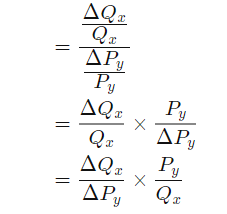Thinking about changing the price of your products but not sure how your consumers will respond to it? Not sure if you will increase sales by dropping the price of an item? Then you need to determine the price elasticity of your products and services.
Understanding price elasticity is important for businesses. It is a measure of how changes in prices impact the buying behavior of users. Price Elasticity helps businesses understand how much they can stretch the price (hence the term elasticity) of any product before it impacts.
Here is what we will cover in this article:
- The concept of Price Elasticity
- Price Elasticity of Demand and its formula
- Price Elasticity of Supply and its formula
- Concept of Cross Price Elasticity and its calculation
- Importance of Price Elasticity
- How are Price Elasticity and Supply & Demand interconnected?
What is Price Elasticity?
We can define Elasticity as a measure of the change in the demanded or supplied quantity of a product based on the change in its price.
In business and the economy, the extent to which people, consumers, and producers change their demand or the amount supplied as a result of changes in prices or revenue refers to the extent of elasticity.
Price elasticity helps us evaluate the change in consumer demand following a change in the price of a good or service.
The sensitivity of one economic factor to another is termed elasticity. An example can be the changes in price to demand. When the demand for a product does not change despite the changes in its prices, then the demand is termed inelastic.
Examples of elastic products/ items: Electronics, apparel/clothing
Examples of inelastic goods: Food, medicines
What is Price Elasticity of Demand (PED)?
Price Elasticity of Demand is a factor that determines the change in consumption or demand of a service or product when its price is changed.
This concept holds importance for economists as they gauge the supply and demand for a product when its price changes.
If a small change in the price of the products has brought along a huge difference in the demand, the product is said to be responsive or elastic, or sensitive.
For understanding and comparing the price elasticity of demand across different commodities, it is essential to understand the responsiveness of the product. Instead of changing their habits, consumers can accept a seasonal price fluctuation.
Understanding Price Elasticity of Demand
Per the definition, if the demand of the product changes with the price change, the product is elastic.
Say, there’s a price increment of 5%, but the demand falls by 10%.
Now, if the change in purchase quantity is the same as the change in price (as 5% / 5% = 1), then the product is considered to have unitary price elasticity.
Conversely, if the change in purchased quantity is less than the price change, then the product is inelastic. (-5% demanded quantity for +10% price change)
Let’s see an illustration of the price elasticity of demand.
If the prices of fruit, say oranges, decrease by 5% and the fruit vendor increases their purchase capacity by 20%.
The elasticity of oranges = 0.20 / 0.05 = 4.
The demand for oranges is elastic.
Price Elasticity of Demand Formula
Here’s the expression to measure PED:
Studying PED enables economists to understand that several goods are inelastic. This means, the demand does not increase despite the reduction in prices, and an increase in price does not impact the demand either.
An apt example of an inelastic item is the vehicle fuel which irrespective of the price increase, does not dwindle in demand. From airlines to the transport industry, the fuel demand will not diminish even if there has been a steady rise in its prices.
Price elasticity is, therefore, an extremely fascinating topic to research upon for marketing experts. Through a market study, they could produce an inelastic demand for their product. It would give them an edge over their competitors apart from boosting the market position of their brand. A groundwork by comparing their product to those of others.
What is Price Elasticity of Supply (PES)?
Price Elasticity of Supply refers to the change in the supply of a good or service in relation to the change in its market price.
The basic economic theory says that the supply of the items increases when their price increases. Likewise, its supply decreases when its market price decreases.
To understand the concept, let’s consider the Law of Supply. In the economic system, producers or manufacturers are constantly competing for profits. As the profits can never be the same across products and time, they tend to invest more in the goods that show a good profit; leaving out the less profitable ones. Consequently, there’s an upsurge in the supply of profitable goods and a decrease in the ones less profitable. This phenomenon is said to be related to the law of supply.
If there are more buyers for oranges than apples, the prices of apples will dive down. The fruit cultivators, after observing this shift, will evidently move towards producing more oranges than apples. It allows them to earn higher profits.
Types of Price Elasticity of Supply
The five types of price elasticity of supply are:
- Perfect Inelastic supply: When there is no change despite the price change, the product is perfectly inelastic. Here, the PES formula is equal to zero.
Example: product found in limited quantities such as artwork of the deceased maestros.
- Relatively inelastic supply: The percentage change in supply is less than the percent change in price. Here the PES formula is in the range of 0 to 1.
- Unit elastic supply: Here, the change in supply percent is the same as the percentage change in its price. The PES value is 1 in this case.
- Perfectly elastic supply: A perfectly elastic supply has an infinite value. In this case, an unlimited quantity can be supplied at a particular price but there’s no supply at any other price.
- Relatively elastic supply: Here, the PES is greater than 1. The percentage supply is much greater than the percentage of price change. This means the supply is relatively elastic.
Price Elasticity of Supply Formula
The formula for PES is:
Let’s take an example to understand the case better.
If the price of fruit increases by 10% with an increase of 20% in its price, then going by the formula:
% change in quantity supplied = 20
% change in price = 10
PES = 20 / 10 = 2
Likewise, if the price of a product decreases by 15% and the percentage of quantity supplied 3%, then
% change in quantity supplied = 3
% change in price = 15
PES = 3 / 15 = 0.2
What is Cross Price Elasticity?
Cross Price Elasticity refers to the measurement of change in the quantity of one good when there’s a change in the price of another good.
Often, this economic concept is also called the Cross Price Elasticity of Demand. It is calculated by dividing the percentage change in the quantity demanded of one good by the percentage change in the price of the other good.
Cross Elasticity of Demand Formula
Cross elasticity is a measure of how change in one product impact another product. This is useful to determine, with a high degree of confidence, if products are interlinked.
The term is evaluated through the given formula:
E= % change in the quantity of x / % change in the price of y

Where Qx = Quantity of Good x
Py = Price of good y
Δ = Change
Understanding Cross Elasticity of Demand
Let’s move toward understanding the concept through substitute goods and complementary goods.
Substitute Goods: For substitute goods, the value of cross elasticity is always positive. This is due to the increase in demand for one good when the price of other goods increases. As evident from the formula, both the numerator and the denominator indicate positive increases.
Unrelated goods have a zero coefficient as they are independent of each other. When the goods have low cross elasticity, they are called weak substitutes. Example: tea and coffee.
Conversely, related goods are strong substitutes such as two different brands of coffee. The price change of one brand affects the demand of the other brand.
Complementary Goods: Contradictory to the substitute goods, the cross elasticity of demand for the complementary goods is negative. It states that as the price of one good increases, the demand for its closely associated item also decreases. This is because the cost of the main product has increased.
Understand it this way: If the cost of tea increases, the consumers are less likely to buy teabags. As the cost of the main product increases which is tea here, the demand for tea bags also decreases.
From the formula, the numerator value denoting the demanded quantity of tea bags is negative and the denominator denoting the price of tea is positive.
With a piece of detailed information on Cross Price Elasticity, let’s also check the importance of price elasticity.
Why is Price Elasticity Important?
Price Elasticity finds application in a wide scheme of things. A company’s success relies on the elasticity of its products to a great extent. The competition gets fierce when there are products with similar elasticity in the market.
On the contrary, the companies that have inelastic products can sit back and can place a higher price tag on their products; as these products are must-haves. With all this information, companies try to sell more inelastic goods as they know that these goods will always find consumers irrespective of the price increase.
Besides this, here are some areas where it plays a vital role including the following:
International Trade: Price elasticity is specifically important when goods are exported. The exporting country (Country A) should be familiar with the elasticity of the product. It may assign higher prices assuming it to be an inelastic product. However, if it is an elastic good in the country that imports it (Country B), then country A will have to assign lower prices to it.
Taxation Policies: For levying an appropriate amount of tax, the government needs to know the elasticity of a product. Inelastic products can attract higher taxes and elastic products are imposed with lower taxes.
What is the Relationship between Price Elasticity and Supply & Demand?
Let’s gather up what we have seen so far to understand the relationship between price elasticity and Supply & Demand.
As we discussed in the previous sections, Price Elasticity is the proportionate change in demand or supply of a good with the change in its price.
So, when the price changes the goods may witness a rise in its demand/ supply or it may witness a decline in its demand/ supply, or there may not be any change in its demand or supply at all.
This will also classify the product as elastic or inelastic.
The knowledge of a product’s elasticity is essential for any business to flourish. A company can then go ahead to fix the prices of goods it produces. If the product is inelastic, the company can fix a higher price for it. Quite the reverse is done for an elastic good which is fixed with a lower price.
In case the product is elastic, i.e. it gets affected by the price then there would be an impact on its demand or supply. Therefore, it can be said that price elasticity is directly related to the demand and supply of a product.
Key Takeaways
Based on the information in the article, here are the key takeaways:
- Elasticity is the proportionate change in quantity over the proportionate change in price.
- Elastic goods are the ones that showcase a change in demand with a price change.
- Inelastic goods do not show any change in demand despite a rise or fall in their price.
- Price elasticity of demand is the change in demand of a product when its price changes.
- Price Elasticity of supply is the change in the supply of a product when its price changes.
- The cross-elasticity of demand is an economic concept that measures the responsiveness in the number of goods required when the price of other goods changes.








